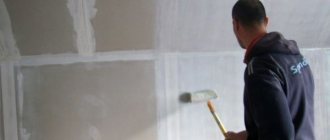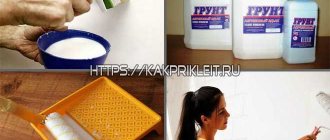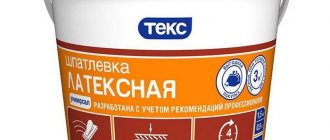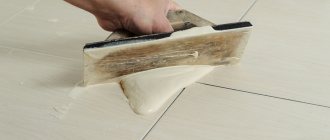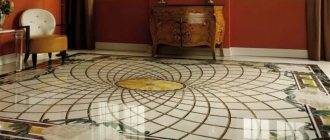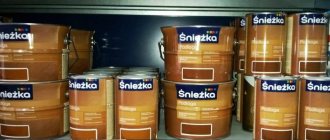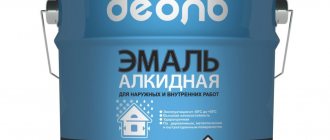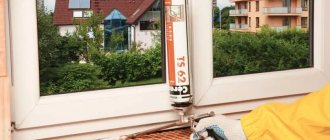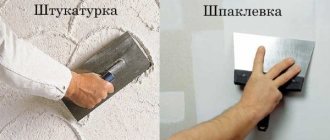Puttying work helps to obtain a smooth surface ready for further finishing. But to get a high-quality result, you need to choose a good composition that has high-quality properties. Among the variety of products, a special place in popularity is occupied by Vetonit LR putty, produced by. But a successful result cannot be obtained only by using a high-quality solution; the work must be done correctly. The features of LR Vetonit and the rules for working with putty will be discussed in detail below.
Features and properties of putty
Vetonit LR finish is a finishing type of putty mixture. It is produced in dry form, the composition is based on polymer, and can be used in rooms with a dry microclimate. It looks like a powder, produced for sale, the composition is in 25 kg bags. LR putty is a mixture, for this reason, in order to apply it, you need to mix it with water, so you get the necessary solution.
The base color is white, so you can give it the desired shade without any problems. This option is not suitable for facade cladding of a room; the layer does not withstand exposure to moisture. For the same reason, it is not used for wet rooms; the composition helps attract moisture, which leads to the appearance of cracks and particles falling off the surface.
For wooden bases, LR putty is not used; the shrinkage process destroys the integrity and evenness of the layer.
Non-resistance to moisture narrows the scope of application of the finishing putty, so the manufacturer is trying to eliminate the shortcoming. Modified versions have appeared, such as LR plus putty, where polymer elements are not used. Suitable for plastered surfaces and concrete.
It is important for the master to know that Vetonit LR cannot be applied in multiple layers, only one layer is allowed, because of this, eliminating differences on the base is impossible.
It is important for the master to know that Vetonit LR cannot be applied in multiple layers; only one layer is allowed.
The materials for which the putty solution is suitable are:
- Lime-cement;
- Gypsum, including drywall;
- Cement.
The solution is well distributed over rough as well as smooth substrates. Mechanized work is allowed, which helps save money by reducing consumption, and also produces a monolithic surface without transition areas.
Vetonit LR should not be used for treating flooring, or for gluing skirting boards to the ceiling. The layer does not withstand weight and mechanical stress.
It is worth understanding that the purpose of the putty mixture is limited to certain points; they are prescribed by the manufacturer on the label. Therefore, you should not use the composition for any other purpose; you simply won’t be able to get the desired result.
The solution is well distributed over rough as well as smooth substrates.
Features of Vetonit finishing putty
Weber is a subsidiary of Saint-Gobain. It is a world leader in the production of dry construction mixtures, including putties, developed using modern technologies. Vetonit is a line of putty mixtures used for cladding the internal and external walls of buildings. The mixture is most often used as a finishing mixture, for finishing walls for painting or wallpapering.
The main qualities include the following features.
- The putty is easy to sand.
- Improves sound insulation.
- Made from natural ingredients.
- Provides a smooth surface.
- The consumption is small.
- Easily lays down and stretches along the wall.
Advantages and disadvantages
Every building material has positive and negative properties. To make a thoughtful choice of putty for indoor renovation work, you should study these product features. If the result is of high quality, then repeated repairs will only be required after many years, and this is a significant saving of money and time.
The advantages include the following:
- The composition is produced using the latest equipment using modern technologies, which helps to obtain high quality;
- Even for beginners, filling the surface may seem like a simple task when choosing LR putty; the solution does not stick to the trowel and does not fall off the base during application;
- A thin layer allows you to level the surface, removing the smallest defects remaining after treating the wall with starting putty;
- The composition is harmless, there are no toxic substances in the mixture;
- The smallest fractions are used, which allows the layer to be uniform, the texture is smooth;
- Grinding is usually not required, but if the master has little experience, then this step is worth carrying out;
- Low consumption, it is recommended to prepare small portions so that there is no excess solution left;
- The use of the diluted mixture is allowed for a long time, it does not lose its properties, the period can reach a day, the painter will not need to rush when working;
- Improves sound and heat insulation in the room;
- After puttying, you can paste wallpaper on top or paint the walls and ceiling;
- Reasonable price considering the consumption rate, easy to find on sale.
A thin layer allows you to level the surface, removing the smallest defects.
Weber Vetonit LR also has disadvantages:
- It is forbidden to dilute the solution a second time, it will have reduced properties;
- The dry mixture must be stored in a room with moderate humidity, moisture leads to spoilage of the powder;
- It is necessary to carefully prepare the surface before work, otherwise the level of adhesion will be low;
- During the renovation period, drafts must not be created in the room;
- You should not make it too thick; such a coating will not be durable; you must follow the manufacturer’s recommendations for application.
If the working technology is violated, then you can end up with wallpaper falling off the wall along with the putty layer.
It is forbidden to dilute the solution a second time; it will have reduced properties.
Features of using putty
We recommend reading our other articles
- What is a motor pump and why is it needed?
- Online store of climate control equipment
- Ceresit quality – practicality and benefit
- Features of the use of high-quality electric motors
Vetonit finishing putty is applied using special equipment or a simple spatula of a convenient size. The procedure for working with this type of mixture is described below.
- The first step is to remove the old coating, if any, or simply clean the wall to remove grease stains, paint, and wallpaper residues. The surface is also washed and dried.
- Irregularities must be marked. You can use a pencil for this. This way, it will be easier to notice areas that need special attention while working.
- Then the wall is plastered with simple putty. All chips, cracks, gouges and other imperfections are smoothed out. The wall is drying.
- Vetonit finishing putty is applied in a very thin layer. Due to the high quality of the product, this is not difficult to do if you have practice.
- After the finishing layer has dried, they go over it with an abrasive, then everything is polished.
- To ensure that the corners are even, they are additionally treated with a spatula.
The average consumption of this putty is 5 kg of mixture per 5 square meters of area, but this figure may differ for different types.
Types of putty Vitonit LR
The manufacturer has created different types of putty mixtures in this line to satisfy the needs of the buyer. At the moment, Vetonit subtypes are being baked: Plus, KR, Pasta, Silk, Fine.
Subtypes differ in their properties and have different compositions. There are types designed for finishing for wallpapering, and a super-finishing option for creating a perfectly smooth surface before painting.
Under the influence of constant humidity, the latter type may turn yellow.
Vetonit KR, Plus and Fine are compositions for work inside the building. They are distinguished by their increased plasticity and are easily distributed over the base, which is important for novice craftsmen. They are applied in a thin layer, simply sanded, creating a white coating for painting. But Eler Plas is not allowed to be applied to previously painted substrates.
LR Fine is not allowed to be chosen for wet rooms, the Silk type includes finely ground marble, Pasta is a ready-made solution, it does not need to be mixed with water for use, the manufacturer also emphasizes that the layer will be durable and will not be covered with scratches.
Pasta is a ready-made solution and does not need to be mixed with water for use.
Methods for applying putty
Leveling walls with putty is done in two ways:
- mechanical spraying (using special equipment);
- applying the putty mixture manually (using spatulas of different sizes).
The latter option is more often applicable for putty polymer materials. It all depends only on the personal preferences and tasks of the person performing the construction work. The putty layer should not exceed 5 mm, otherwise the coating will dry out for a long time and unevenly.
When applying several layers of putty, each subsequent layer is applied only after the previous one has completely hardened.
On video: tips on puttying walls from experts.
Technical characteristics (drying time, etc.)
The technical characteristics of the Weber brand composition determine its purpose. The manufacturer prescribed the following properties:
Not moisture resistant;
The filler is white limestone;
- The connecting element is polymer glue;
- The prepared solution can be used within 24 hours;
- Temperature indicators required during operation are from +10 to +30 degrees;
- Drying at temperatures from +10 degrees is 48 hours, if they reach +20, then 24 hours;
- The maximum permissible layer thickness is 2 mm;
- Fraction size up to 0.3 mm;
- Water consumption is 0.32-0.36 liters per kilogram;
- Complete setting takes 28 days;
- The level of adhesion to the concrete base after 28 days reaches at least 0.5 mPa;
- Resistance to dirt is low;
- No dust is generated after sanding;
- You can apply the composition with a wide spatula or by spraying;
- Shelf life 1.5 years;
- After drying the layer on the walls, you need to sand it; the ceiling does not need to be sanded.
The technical characteristics of modified compounds may be slightly different, and this allows them to be used with different materials; the manufacturer also claims that their strength and quality are higher.
The prepared solution can be used within 24 hours.
Types of Vetonit putty
Also check out these articles
- Selection of children's cosmetics
- History of the computer
- Why is it worth buying a key for Microsoft Office?
- Advantages of brush holders MTN, MTF for crane electric motors
Finishing putty Vetonit comes in different versions. To begin with, a distinction is made between gypsum, polymer and cement mixtures. According to the release form, there is a paste-like mass in buckets and a dry, undiluted mass. The latter is sold in three-layer paper bags of 5 and 25 kg.
Different types of finishing putty are produced under different markers.
- "VH" is a mixture made from cement binder and limestone aggregate. Can be used in damp areas.
- "KR" is used only in dry rooms. Requires correct application. After drying it has a stable, white color.
- “LR Pasta” and “LR+” are polymer putties designed for use in dry rooms with normal humidity.
Photo of Weber Vetonit LR+, VH, LR Pasta putty
Weber Vetonit LR+
Weber Vetonit LR+ finishing putty is sold in three-layer paper packaging, weighing 20 and 25 kg. Shelf life 1.5 years. The mixture is white, crumbly, and consists of polymers and finely ground marble.
This type of putty is suitable for leveling indoor surfaces (where it is dry). It is not recommended for the street or bathroom or kitchen, because it turns yellow with prolonged exposure to moisture.
To obtain a working mass, water is added to the mixture. For 25 kg, you need about 8-9 liters of water. The result is a snow-white mass that can be used for 24 hours, then it will deteriorate. Always apply only to a clean wall free of grease. It should be dry and hard. Application layer – 1-5 mm. Movements should be smooth, from bottom to top. In order for the Weber Vetonit LR+ polymer finishing putty to dry quickly (in 24 hours), the room must be +10...+30 degrees and have good ventilation.
Vetonit LR Pasta
This type of putty is necessary for super-finish leveling of a wall or ceiling. Can only be used in a dry room. Allows you to create a perfectly flat surface for paint. Made from limestone and polymer glue. Suitable for leveling concrete and plastered surfaces.
It is a white paste, located in buckets of 20 kg (12 l) and 5 kg (3 l). It is already ready for use, no dilution is required. Conveniently applied in a layer of 0.2-0.3 mm. At a room temperature of +20, and a layer thickness of 0.5 mm, this polymer finishing putty dries in 4 hours.
Weber Vetonit VH
This putty option is convenient because it can be used in rooms with any humidity. It is suitable for finishing concrete and brick inside or outside buildings. However, it will not adhere to surfaces treated with water-soluble or lime-based products!
Before using this putty, you need to clean the wall, then prepare the working composition. It is diluted with water, beaten with an electric drill for 5 minutes and then left for 3 hours. You can apply it with a spatula, which is convenient for work. Movements should be smooth to avoid unevenness. One layer dries in up to 3 days.
Vetonit KR
Finishing putty Vetonit KR is created using organic glue (binder). It is completely white and looks beautiful. Suitable for final leveling of surfaces. The advantages include the smoothness of the surface after drying, plasticity, and ease of work. If the container for the diluted mixture is closed, then it can be used for 2 days in a row! Sold in paper bags weighing 5 kg and 20 kg. Shelf life up to 1.5 years.
The mixture can be applied mechanically or manually. Used on walls and ceilings that have been pre-leveled or on plasterboard boards. It is recommended to apply a layer of 0.3 mm, but thicker is possible. Layers dry for 24 hours.
Photo finishing putty Vetonit KR
Rules for calculating consumption
The average consumption rate is written in kilograms per square meter of surface. Vetonit LR putty consumption of 1 m2 is 1.2 kilograms. But the peculiarities of work and premises make adjustments to this indicator. What should be taken into account when calculating the required amount of mixture for repairs.
To calculate the quantity, you need to find out the area of the base and multiply the figure by the consumption indicated by the manufacturer. To avoid having to run to the store again due to insufficient volume of the mixture, experts recommend purchasing putty with a reserve.
If stored properly, excess putty mixture can last for another 12 months. The consumption is greatly influenced by the thickness of the layer; it is not always possible to make the layer as thin as the manufacturer took into account when calculating. Therefore, a reserve will not hurt; usually it is 15-20% of the total mass.
The consumption is greatly influenced by the thickness of the layer; it is not always possible to make the layer as thin as the manufacturer took into account when calculating.
Finishing putty Weber Vetonit LR plus (Weber.vetonit LR +) 25 kg.
- Leveling walls and ceilings inside dry rooms
- Finishing putty, layer thickness: 1-5 mm
If you do not find the necessary information here, call: 8, 73-99-80 , you can also send a request or a site plan for calculating the amount of dry mixture by fax: 8 (3952) 599-250 or email [email protected] , Our specialists will calculate the required amount of material. There is NO pickup for this product group. It is possible to pay for the order upon delivery, delivery within Irkutsk is 600 rubles! (up to 1 ton)
Preparing the base
The base must be solid, clean, free from dust and dirt. Substances that weaken adhesion such as grease, dust, etc. must be removed. The base must be dry. Excess moisture in the structure can cause yellowing of the leveled surface. Windows and other untreated surfaces must be carefully protected.
Preparing the mixture
Fill the container with approx. 9.0 liters of clean water and add 25 kg (bag) of weber.vetonit LR + mixture, and the mixture must be added to the water, and not vice versa. Recommended water temperature is 20°C. Mixing is done with a powerful drill with an attachment for 3-5 minutes. To better dissolve the binder, the mixture is allowed to stand for 10 minutes. After light re-stirring, the mixture is ready for use. The mortar mixture is suitable for use within 24 hours from the moment of mixing with water. When storing the finished mixture in a closed container, the putty is suitable for use for 2 days. The temperature of the mortar mixture must be at least +10°C.
Application
The mortar mixture is applied by mechanized spraying or manually and leveled using a two-handed steel spatula. For partial leveling, use a smaller steel spatula 30cm wide. When leveling in several layers, it is necessary to apply each subsequent layer on the completely dry previous one. The dried surface of the putty must be treated with sanding paper and removed from dust before applying the next layer. After sanding, the leveled and dry surface can be painted or wallpapered according to the instructions of the manufacturer of these materials, or left uncovered when creating a rough “fur coat” surface using a mechanized spraying method.
Drying time
Drying time for one layer of recommended thickness at +10 °C is approximately 2 days; at +20 °C approx. 1 day, with good ventilation. Drying time depends on layer thickness, ventilation and temperature.
Finishing putty Weber "Vetonit LR" plus 25 kg.
You can buy Weber finishing putty “Vetonit LR” plus 25 kg. in our online store at an affordable price. Finishing putty Weber “Vetonit LR” plus 25 kg: description, photo, characteristics.
Dear customers. Before visiting the office, be sure to call: 89501118580
Irkutsk, st. Klara Zetkin, 12 location map
Source
How to prepare the solution
The instructions describe the rules for preparing the solution; they should be strictly followed, and the amount of water and mixture should be accurately measured. This factor has a significant impact on the quality and properties obtained from the solution during application. It is required to prepare as follows:
- Choose a clean and dried container that is suitable in size.
- For mixing, it is better to use a construction mixer or a drill with an attachment for mixing solutions.
- Take 8-9 liters of water into a container, use only clean water at room temperature.
- The mixture is poured from the bag into the water.
- Stir the ingredients, you need to set the speed to low, and stir the components for 2-3 minutes until the mass becomes homogeneous.
- Afterwards, the solution should infuse for about ten minutes.
- Then stir the composition again.
Environmental influences somewhat change the properties of the solution, so even taking into account the manufacturer’s instructions about the suitability of using the finished composition for 24 hours, it is advisable to have time to apply it without much delay.
Over time, the putty becomes thicker and will not be as easy to apply. It is impossible to say exactly how long it will take for the layer to dry; the process is affected by temperature and humidity levels.
For mixing, it is better to use a construction mixer or a drill with an attachment for mixing solutions.
Tips for making a solution
In order to achieve optimal consistency and structure, dry putty must be diluted with water, adhering to the proportions noted in the instructions. The result should be a mass of homogeneous composition of medium viscosity.
Before mixing the components, remember that water must be added to the solution in small portions. Its temperature should be approximately 20 degrees.
Experts give some advice on this matter:
- Ten to fifteen minutes after preparing the mixture, it needs to be mixed with a construction mixer.
- Several hours (no more than 24) should pass before the composition is used after mixing. If you neglect this rule, the mixture will harden and lose its performance properties.
- The dry mixture should be stored in a dark, dry and cool place.
How to apply the solution
The convenience of this putty material is the possibility of manual and mechanical application. With the manual method, the composition is collected with a trowel and distributed over the base using a rule and a trowel. This technology is very good if you want to make putty a decorative coating. This allows different shades to be applied across a surface to create an unusual effect, such as marblework. But they monitor the thickness of the layer, it is kept to a minimum.
The second option is fast. But it requires a suitable device. A sprayer with a large nozzle is suitable. There are craftsmen who use a cholera construction bucket that they made themselves. The solution comes out of the ladle very quickly, so treatment of the entire area does not take long. Leveling the layer on the surface is carried out according to the rule. As a result, even large rooms can be plastered without wasting a lot of time.
The choice of method depends on the skills of the master and the availability of suitable tools. For one-time repairs, it is not advisable to purchase a sprayer.
LR putty is a high-quality product that helps to obtain a ready-made base for decorative finishing with any materials, and can also serve as a finishing when using shades other than the base one.
The convenience of this putty material is the possibility of manual and mechanical application.
But in order to get a long-lasting result, you must not neglect the operating rules prescribed by the manufacturer. Due to the ease of application, even a beginner can cope with this task, which will save money if you do not turn to the services of professionals.
Preparation of the solution
To prepare putty with optimal structure and consistency, dilute the dry mixture with water in accordance with the proportions indicated on the package. The result should be a homogeneous mass of medium density.
Before diluting the putty mixture, you should know that water must be added to the solution in portions, and its temperature should be approximately 20 degrees.
There are some professional tips to follow:
- After the finished putty has infused a little (for 10-15 minutes) and acquires a more uniform texture, it should be thoroughly mixed again using a construction mixer.
- After mixing the solution, no more than 24 hours should pass until the putty is applied, otherwise the mixture will lose its properties and harden.
- If there is still dry mixture left in the package, it is recommended to store it in a cool (but dry) and dark place.
Characteristics and description of Vetonit polymer putty
Repair work often includes finishing walls. To get a durable and reliable result, you need to level the walls before moving on to finishing work. For this purpose, putty mixtures are used. There are a huge number of different options for such products on the market, among which the top positions are occupied by Vetonit putty. More information about what Vetonit is will be discussed below.
Application nuances
Vetonit compositions, which are recommended for use in rooms with high humidity, require taking into account a number of rules:
- The best results are obtained on gypsum, plasterboard and mineral bases;
- The compositions contain fine fillers and provide a smooth base, but in most cases it is better not to lay tiles on them;
- It is not allowed to apply the solution to a surface treated with self-leveling agents;
- JS type is used for joint areas and seams; it is suitable for finishing coating when laying tiles in pools, baths, and bathrooms.
Any substrate can be coated using the mechanical method; the compositions make it possible to coat complex materials, an example is a wooden surface. The main thing is to thoroughly clean the wall or ceiling of dirt and degrease it.
The best results are obtained on gypsum, plasterboard and mineral bases.
Preparation of the solution, how to dilute the mixture
When a dry version of the mixture is purchased, it is important to know how to dilute Vetonit. On the packaging itself, in the form of bags, the rules for diluting the compositions are prescribed. It is necessary to strictly observe the proportions of the mixture and water, as well as the time required to prepare the solution and store it.
These parameters vary depending on the type of mixture. For example, Vetonit base putty will be prepared slightly differently from its final appearance. Mixing is carried out in a clean container; it is advisable to use a construction mixer to obtain a homogeneous mass.
Mixing is carried out in a clean container, preferably using a construction mixer.
Leveling steps
As mentioned earlier, you can work manually; spatulas of different sizes are used. Also by spraying using special devices. Alignment is carried out in the following steps:
- The surface is cleaned of old finishes, all types of contaminants, and degreased.
- All bulges are identified and removed. Chalk marks areas of unevenness in the form of dents and cracks.
- These areas are treated with a medium spatula.
- Wait for time for the mixture to dry; windows and doors cannot be opened during this time (interior doors can be opened).
- Next, the finishing type of putty is applied, when it dries, the surface is sanded. The corner parts are leveled with a corner spatula.
You can work manually; spatulas of different sizes are used.
Finishing putty Vetonit KR with an organic binder
Vetonit KR – finishing putty for ceilings and walls. It is used to create a thin layer, which will then be covered with paint or wallpaper. Can be applied either manually or mechanically. The recommended layer thickness is 1-3 mm, while the consumption will be, as in previous options, 1.2 kg/sq.m.
Finish white with organic binder
Application area
To use the diluted mixture, 24 hours are given, after which the material hardens and loses its binding properties. The composition contains organic glue as a base, so the material is ideal for organic surfaces in the form of drywall. It is not recommended to use the product:
- when working with floor coverings;
- for installation of ceramic tiles;
- in rooms with high humidity levels;
- to remove seams.
Method of application and consumption
Before performing work, you should mix 25 kg of the mixture with 8 liters of water; for this you need to use a drill with an attachment. It is important to remember here that it is the powder that is poured into the liquid, but not vice versa. After obtaining a thick, homogeneous mass, which was achieved by whipping for 10 minutes, you need to leave it to infuse for 20 minutes, then stir vigorously again.
To perform the work, use 2 types of spatula:
- small with a width of 30 cm;
- large – 70 cm.
The material is applied in one or 2 even layers, taking into account the complete drying of each. If the optimal level of humidity in the room is created, as well as temperature and air circulation, one layer will dry in 2-3 days, after which you can safely begin decorative cladding.
